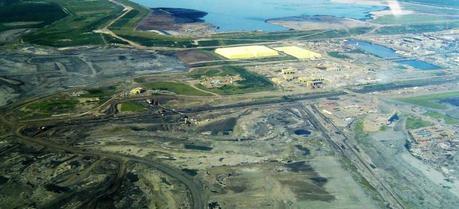 New clean energy developed at UBC could conserve billions of litres of water in Alberta’s oilsands. On the photo: Syncrude's Mildred Lake mine site and plant. (Credit: Wikimedia Commons)
New clean energy developed at UBC could conserve billions of litres of water in Alberta’s oilsands. On the photo: Syncrude's Mildred Lake mine site and plant. (Credit: Wikimedia Commons)A team of clean energy researchers at the University of British Columbia has received a $500,000 grant to commercialize a new technology that converts excess carbon dioxide and wastewater from the oil and gas sector into reusable water and valuable chemicals.
The UBC research team led by Professor David Wilkinson with team members Dr. Arman Bonakdarpour, Dr. Alfred Lam and PhD Candidate Saad Dara in collaboration with SFU’s Professor Steven Holdcroft, received $500,000 in funding from the Climate Change and Emissions Management Corporation (CCEMC) to further the new technology towards commercialization. The project was one of 20 finalists chosen from over 344 international submissions.
This development could serve the dual purpose of reducing global carbon dioxide emissions and addressing the issue of decreasing global water reserves.
“A lot of technologies look at these issues as two separate problems but we are simultaneously addressing both of them,” says David Wilkinson, a professor of chemical and biological engineering and a member of the Clean Energy Research Centre.
The technique uses an advanced low-energy dialysis system that employs excess carbon dioxide to desalinate industrial wastewater. Unlike existing desalination technologies, such as evaporation and reverse osmosis where the only output is desalinated water, the low-energy dialysis innovation desalinates water and significantly reduces the carbon footprint by producing valuable chemicals from waste CO2 on site.
A major market is the growing oil and gas industry. In Alberta, wide-scale adoption of their method would remove several megatons of carbon dioxide and conserve several billion liters of water every year, says Wilkinson
“Water management is one of the major issues facing unconventional oil and gas developments,” says Jean-Michel Gires, Chrysalix EVC Venture Partner and former CEO Total E&P Canada, a leading global oil and gas company. ”This is why water management innovation is very welcome to provide better and more sustainable solutions to these issues.”
Wilkinson’s innovation could be used in any jurisdiction where salty water and waste carbon dioxide are present.
In the U.S., the production of tight oil and shale gas, which are difficult to extract through typical drilling methods, uses 97 billion gallons of water annually. The industry wants to reduce its reliance on water as more than 50% of oil and gas wells in North America are located in areas where water resources are limited.
The CCEMC funding will be used to demonstrate efficacy with model and customer wastewater and demonstrate a scaled up commercial-sized dialysis cell. At commercialization the novel system is anticipated to reduce carbon dioxide in excess of 1 megatons per year—the equivalent of 200,000 cars; and reduce fresh water use in excess of 2 billion liters per year—a savings of over 800-Olympic sized-swimming pools for tight oil and shale gas extraction in Alberta. The system has the potential for use in any jurisdiction where brine and waste carbon dioxide are present.

